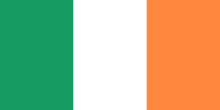ชาวไอริช
 | |
| ประชากรทั้งหมด | |
|---|---|
ป. 70–80 ล้านคน[1]
 | |
| ภูมิภาคที่มีประชากรอย่างมีนัยสำคัญ | |
| ไอร์แลนด์เหนือ 1,900,200[3] | |
| มากกว่า 40 ล้านคน[4] | |
| 14,000,000 (รุ่นแรก: 650,000)[5][6] | |
| 7,000,000[7] | |
| 4,627,000[8][9] | |
| 600,000[10] | |
| 500,000[11] | |
| 120,000[12] | |
| 15,000[13] | |
| 10,000 | |
| ภาษา | |
| ศาสนา | |
| ส่วนมาก: คริสต์นิกายโรมันคาทอลิก ส่วนน้อย: คริสต์นิกายโปรเตสแตนต์, คริสต์นิกายเพรสไบทีเรียน และคริสต์นิกายแองกลิคัน) | |
| กลุ่มชาติพันธุ์ที่เกี่ยวข้อง | |
| ชนร่อนเร่ชาวไอร์แลนด์, แองโกล-ไอริช, เบรตอน, คอร์นนิช, อังกฤษ, ไอซ์แลนด์[14], แม็งซ์, ไวกิง, สกอต, อัลสเตอร์-สกอต, เวลส์ | |
ชาวไอริช (ไอริช: Muintir na hÉireann หรือ na hÉireannaigh หรือ na Gaeil, อังกฤษ: Irish people) เป็นกลุ่มชาติพันธุ์ชาวยุโรปตะวันตกที่มีถิ่นฐานดั้งเดิมอยู่ในประเทศไอร์แลนด์ ทางตะวันตกเฉียงเหนือของทวีปยุโรป จากหลักฐานทางโบราณคดี ไอร์แลนด์เป็นที่ตั้งถิ่นฐานของมนุษยชนมาราว 9,000 ปีโดยมีบรรพบุรุษของชาวไอริช[15] ที่เป็นชนเนเมเดียน (Nemedians), ชนโฟโมเรียน (Fomorians) และชนมิเลเซียน (Milesians) (ตามตำนาน - ไม่มีหลักฐานบันทึกเป็นอักษรก่อนคริสต์ศตวรรษที่ 6) โดยกลุ่มสุดท้ายถูกกล่าวกันว่าเป็นกลุ่มที่เป็นบรรพบุรุษเกลลิคที่แท้จริงและยังคงใช้เป็นคำที่เรียกชนไอริชจนกระทั่งปัจจุบันนี้ กลุ่มชาติพันธุ์หลักที่มีการติดต่อกับชาวไอริชในยุคกลาง ได้แก่ ชาวสกอต ชาวไวกิง และชาวไอซ์แลนด์โดยเฉพาะที่มีเชื้อสายไอริช การรุกรานของแองโกล-นอร์มันในตอนกลางของยุคกลาง, การก่อตั้งดินแดนของอังกฤษ และต่อมาการปกครองโดยอังกฤษเป็นการนำกลุ่มชนนอร์มัน, เวลส์, เฟลมมิช, แองโกล-แซกซัน และเบรตอน เข้ามาในไอร์แลนด์
ชาวไอริชหลายคนมีชื่อเสียงมาตลอดในประวัติศาสตร์ตั้งแต่คริสต์ศตวรรษที่ 6 จนถึงปัจจุบัน เช่น โจนาธาน สวิฟท์, จอร์จ เบอร์นาร์ด ชอว์, เลียม นีสัน, ออสการ์ ไวลด์, คิลเลียน เมอร์ฟี, เจมส์ จอยซ์ และริชาร์ด แฮร์ริส
อ้างอิง
- ↑ ceu@scotland.gsi.gov.uk, Scottish Government, St. Andrew's House, Regent Road, Edinburgh EH1 3DG Tel:0131 556 8400 (29 May 2009). "The Scottish Diaspora and Diaspora Strategy: Insights and Lessons from Ireland". www.scotland.gov.uk.
- ↑ Ethnic Irish at Ethnologue (22nd ed., 2020)
- ↑ Demography of Northern Ireland
- ↑ American FactFinder, United States Census Bureau. "U.S. Census Bureau, 2007". Factfinder.census.gov. คลังข้อมูลเก่าเก็บจากแหล่งเดิมเมื่อ 10 April 2010. สืบค้นเมื่อ 2010-05-30.
- ↑ "One in four Britons claim Irish roots". BBC News. BBC. 16 March 2001. สืบค้นเมื่อ 7 December 2020.
- ↑ Maybin, Simon (2 September 2016). "How many Britons are entitled to an Irish passport?" – โดยทาง www.bbc.co.uk.
- ↑ "Department of Foreign Affairs - Emigrant Grants". 28 July 2013. คลังข้อมูลเก่าเก็บจากแหล่งเดิมเมื่อ 28 July 2013.
{cite web}: CS1 maint: bot: original URL status unknown (ลิงก์) - ↑ "Ethnic Origin, both sexes, age (total), Canada, 2016 Census – 25% Sample data". Canada 2016 Census (ภาษาอังกฤษ). Statistics Canada. 2019-02-20. สืบค้นเมื่อ 30 January 2020.
- ↑ "Ethnic Origin (264), Single and Multiple Ethnic Origin Responses (3), Generation Status (4), Age Groups (10) and Sex (3) for the Population in Private Households of Canada, Provinces, Territories, Census Metropolitan Areas and Census Agglomerations, 2011 National Household Survey". Statistics Canada. 2011.
- ↑ "The Irish in New Zealand: Historical Contexts and Perspectives - Brian Easton". www.eastonbh.ac.nz.
- ↑ "Flying the Irish flag in Argentina". Western People. 14 March 2008. คลังข้อมูลเก่าเก็บจากแหล่งเดิมเมื่อ 14 October 2007. สืบค้นเมื่อ 4 July 2008.
- ↑ O'Higgins Tours. "Los irlandeses en Chile". สืบค้นเมื่อ 10 January 2010.
- ↑ "Présentation de l'Irlande". France Diplomatie : : Ministère de l'Europe et des Affaires étrangères.
- ↑ Helgason, Agnar; และคณะ (2000). "Estimating Scandinavian and Gaelic ancestry in the male settlers of Iceland". The American Journal of Human Genetics. 67 (3): 697–717. doi:10.1086/303046. PMC 1287529. PMID 10931763.
- ↑ Boylan, Henry (1998). A Dictionary of Irish Biography, 3rd Edition. Dublin: Gill and MacMillan. pp. xvi. ISBN 0-7171-2945-4.